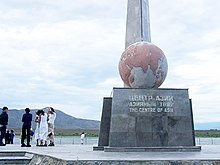Kyzyl: Difference between revisions
No edit summary |
|||
| Line 3: | Line 3: | ||
[[Image:Ru200107280198.jpg|thumb|Shaman dancing near Kyzyl]] |
[[Image:Ru200107280198.jpg|thumb|Shaman dancing near Kyzyl]] |
||
'''Kyzyl''' ([[Tuvan language|Tuvan]] and {{lang-ru|Кызы́л}}) is a [[types of inhabited localities in Russia|city]] is the capital of the [[Tuva|Tuva Republic]], [[Russia]]. The name of the city means "red" in Tuvan (as well as in many other [[Turkic languages]]). Population: 105,931 (2004 est.); 104,105 ([[Russian Census (2002)|2002 Census]]). Kyzyl is served by [[Kyzyl Airport]]. |
'''Kyzyl''' ([[Tuvan language|Tuvan]] and {{lang-ru|Кызы́л}}) is a [[types of inhabited localities in Russia|city]], and is the capital of the [[Tuva|Tuva Republic]], [[Russia]]. The name of the city means "red" in Tuvan (as well as in many other [[Turkic languages]]). Population: 105,931 (2004 est.); 104,105 ([[Russian Census (2002)|2002 Census]]). Kyzyl is served by [[Kyzyl Airport]]. |
||
==Geography== |
==Geography== |
||
Revision as of 23:50, 7 November 2007



Kyzyl (Tuvan and Russian: Кызы́л) is a city, and is the capital of the Tuva Republic, Russia. The name of the city means "red" in Tuvan (as well as in many other Turkic languages). Population: 105,931 (2004 est.); 104,105 (2002 Census). Kyzyl is served by Kyzyl Airport.
Geography
Kyzyl claims to be located exactly in the geographical center of Asia (coordinates 51°43′11″N 94°26′18″E / 51.71972°N 94.43833°E). Whether these coordinates are in fact the center of Asia is disputed. However, there is a monument labelled "Centre of Asia" in English, Russian, and Tuvan which asserts this claim. Tos-Bulak is the area of open fields and mineral springs which lies immediately south of Kyzyl.
Kyzyl is located where the Yenisei River meets the Little Yenisey River to form the Upper Yenisey.[1] Most development is south of the river and follow the curves of the river, with the highest development centered where the two headstreams of the Yenisei, the Bolshoi Yenisei and the Malyy Yenisei, meet. A monument was built in 1964 on the river bank to mark this.
Buildings of cultural and political importance in Kyzyl include the Tuvan Parliament building, the National Theater, and a Khoomei center (officially, the International Scientific Center "Khoomei") dedicated to studying and teaching khoomei, Tuvan throatsinging.
History
Kyzyl was founded in 1914 as Belotsarsk (Белоца́рск). In 1918, the town was renamed Khem-Beldyr (Хем-Белды́р), and in 1926—Kyzyl.
In the late 1980s, Kyzyl was visited by Ralph Leighton, who had made it a quest to reach Tuva with his friend, the Nobel prize-winning physicist Richard Feynman. Though Feynman died before they reached Tuva, the journey is chronicled in "Tuva or Bust"!.
Inspired by Feynman's quest and the desire of a blind blues performer, Paul Pena, who learned Tuvan throat singing by listening to his shortwave radio, to compete in the Tuvan throat singing competition. The film "Genghis Blues" chronicles the pilgrimage.
In September 2004 Kyzyl celebrated its 90th anniversary as a city and the 60th anniversary of Tuva joining the Soviet Union.
Industry
The city primarily provides motor transport services. Manufacturing plants include brickyards, sawmills, furniture manufacturing, and food-processing plants.[2]
Notes
External links
![]() Media related to Kyzyl at Wikimedia Commons
Media related to Kyzyl at Wikimedia Commons
